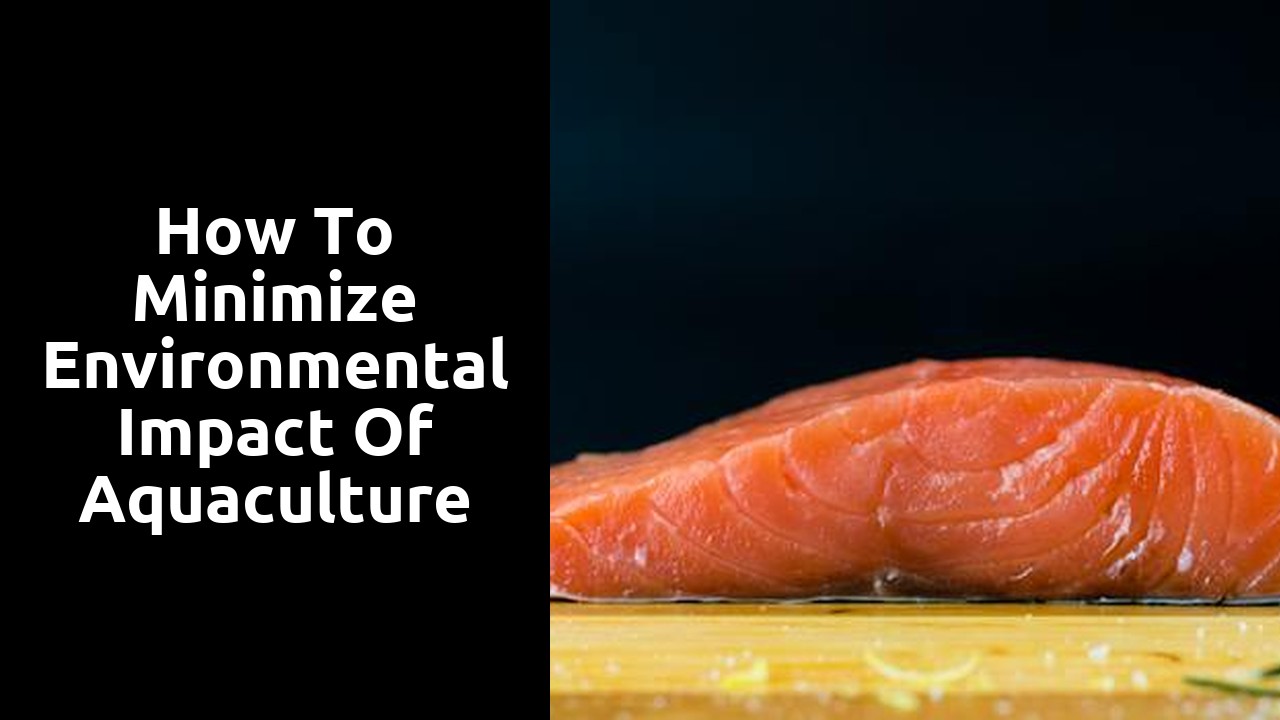How to Minimize Environmental Impact of Aquaculture

Responsible Feed Practices
One key aspect of minimising the environmental impact of aquaculture is through implementing responsible feed practices. Fish feed production is a major contributor to environmental degradation and overexploitation of marine resources. To combat these challenges, it is crucial for aquaculture operators to adopt sustainable feed sourcing methods that prioritise environmental protection.
Utilising alternative protein sources for fish feed, such as plant-based proteins or insects, can help alleviate the pressure on wild fish stocks and reduce the reliance on fishmeal and fish oil. By diversifying the feed sources and incorporating more sustainable ingredients, aquaculture operations can lower their ecological footprint and contribute to the long-term health of marine ecosystems.
Using Alternative Protein Sources for Fish Feed
Aquaculture plays a significant role in meeting the growing global demand for seafood. However, the use of traditional fish feed that heavily relies on wild-caught fish contributes to overfishing and puts a strain on marine ecosystems. To address this challenge, the aquaculture industry is increasingly exploring alternative protein sources for fish feed. These alternatives include plant-based proteins, insects, algae, and single-celled organisms, which can help reduce the reliance on fishmeal and fish oil derived from wild fish stocks.
Innovations in feed formulation have led to the development of feeds that are nutritionally balanced and environmentally sustainable. By incorporating alternative protein sources into fish feed, aquaculture operations can lessen their impact on the environment, conserve marine resources, and promote a more circular approach to food production. Moreover, using alternative protein sources can help enhance the efficiency and cost-effectiveness of aquaculture, making it a more sustainable practice in the long run.
Coastal Habitat Protection
Coastal habitat protection is crucial to safeguarding the delicate ecosystems that are often impacted by aquaculture practices. Implementing designated no-go zones for aquaculture activities can help protect vulnerable coastal areas and ensure the preservation of essential habitats for marine species. By establishing clear boundaries where aquaculture is prohibited, we can prevent detrimental effects on biodiversity and maintain the health of coastal environments.
Furthermore, it is essential to engage in continuous monitoring and regulation of aquaculture activities to uphold strict environmental compliance standards. By enforcing these regulations effectively, we can mitigate the negative impact of aquaculture on coastal habitats and promote sustainable practices that support both marine life and local communities. The combination of protective measures and proactive oversight is key to minimising the environmental footprint of aquaculture operations along coastlines.
Implementing NoGo Zones for Aquaculture
Implementing No-Go Zones for aquaculture is a crucial step towards minimizing the environmental impact of this industry. By designating specific areas where aquaculture activities are prohibited, we can protect vulnerable ecosystems and reduce the risks of habitat destruction and pollution.
These No-Go Zones serve as important sanctuaries for marine species and habitats, helping to maintain biodiversity and support the resilience of coastal ecosystems. By carefully planning and enforcing these areas, we can strike a balance between aquaculture development and environmental conservation, ensuring the long-term sustainability of our oceans.
Monitoring and Regulation
In the realm of aquaculture, the efficacy of environmental monitoring and regulation cannot be overstated. Ensuring that fish farming activities adhere to stringent standards is vital for safeguarding marine ecosystems. Through robust monitoring mechanisms, authorities can promptly detect and address any potential adverse impacts on water quality, marine life, and coastal habitats. By enforcing strict regulations, the industry is held accountable for its practices and compelled to operate in a sustainable and responsible manner.
Effective regulation involves conducting regular inspections of aquaculture facilities to assess compliance with environmental guidelines. By meticulously monitoring factors such as waste disposal, feed management, and disease control, regulatory bodies can mitigate the ecological footprint of aquaculture operations. Implementing transparent reporting mechanisms and fostering collaboration between stakeholders are instrumental in upholding accountability within the industry. Through proactive monitoring and stringent regulation, aquaculture can thrive while minimising its environmental footprint, paving the way for a more sustainable future.
Enforcing Strict Environmental Compliance Standards
To ensure the sustainability of aquaculture practices, enforcing strict environmental compliance standards is imperative. Regulatory bodies must rigorously monitor aquaculture operations to guarantee that they adhere to the established guidelines. By implementing thorough inspections and audits, authorities can hold fish farms accountable for any violations and deter them from engaging in practices that harm the environment.
Moreover, penalties for non-compliance should be significant enough to act as a deterrent and motivate aquaculture facilities to operate within environmentally friendly parameters. These penalties could range from fines to temporary shutdowns, depending on the severity of the violation. By imposing consequences for negligence, regulatory bodies can create a culture of compliance within the aquaculture industry, ultimately reducing its environmental impact.
Related Links
What Are the Best Aquaculture Practices for Sustainability?How to Choose Sustainable Aquaculture Practices
Roundup of Sustainable Aquaculture Practices
Review of Aquaculture Certification and Labeling
5 Sustainable Aquaculture Practices You Should Know
The History of Aquaculture Practices
Why Aquaculture Environmental Impact Should Be Considered
Why Sustainable Aquaculture Practices Matter